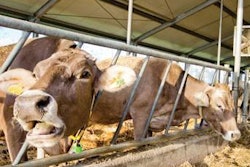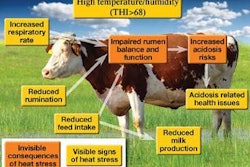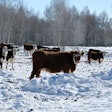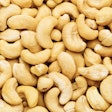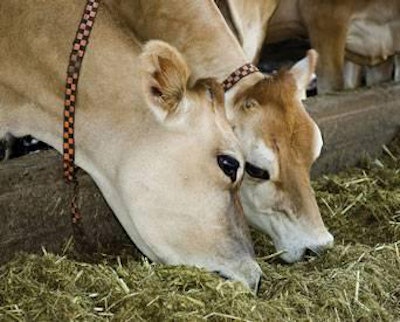
Researchers with the French National Institute for Agricultural Research (INRA) have created a new generation of feed unit systems for ruminants. Systali, a system based on nutrient flows and the multiple animal responses to them, highlights the central role of digestive interactions on diet efficiency.
New system meets nutrition need
Establishing a ration for ruminants is very different from formulating monogastric feed rations because the rumen has its own way of functioning.
Nowadays, several feed evaluation systems exist around the world, but they have some limits regarding emerging challenges in ruminant nutrition, such as acidosis prevision and methane emissions. The current systems simplify the nutritional path of the ruminant digestive tract and are based on animal and ration averages. As a result, they generally do not predict feed conversion efficiency with precision nor do they accurately account for product quality, animal health and emissions to the environment. They also do not cover the “limit” regarding either very low or very highly intensive diets.
Four years ago, 20 researchers in the INRA created a working group called the “Systali” project to address these issues. The team has been analyzing all published data on digestive, metabolic and productive responses in ruminant diets and, through meta-analysis, they’ve been able to integrate them all within a “new generation” feed unit system.
Daniel Sauvant, member of the INRA research team, explains: “This very heavy job had been translated in mathematical equations, which explain the way animals respond to any feed change. We succeeded in increasing the precision of our equations as they are based a very large number of studies. At the same time, we’ve been able to simplify some equations to be more practical for farmers.”Digestive interactions, a real key of nutrition
One of Systali’s main innovations involves accounting for the digestive interactions and of the nutrient flow in the digestive tract.
For example, the proteins ingested by the cow will be, neither in volume nor in size, the ones that pass through the duodenum. First of all, rumen flora will use part of the ingested amino acid for its own needs, known as the rumen degradable protein fraction. Second, it will produce bacterial proteins, which enter the nutriment flow measured at the entrance of the intestine. Bacterial proteins and rumen bypass the protein fraction that will be use by the animal for its own need and production. The difference between the ingestion and the flow at the entrance of the duodenum is named, “BalProRu,” which means “protein balance through rumen.”
In order to meet their needs and be able to produce this kind of protein, the rumen bacteria require energy. The quality and the quantity of energy provided through the ration intake influence a lot of the rumen’s functioning. We know the risk of acidosis is linked to an unbalanced diet with, for example, too many grains and not enough fibers. We also know that feed intake influences methane production. Both of those example show how much the nutrient flow will influence milk production, meat production and animal health. Precision and simplicity
Systali renovates the INRA’s digestive proteins (PDI) and forage unity (UF) from the previous system. It doesn’t get rid of it, but adds to its precision. For example, before, it wasn’t able to predict how animals would react to feed change. The new model is based on a full model including the digestive tract, rumen and intestine. It predicts volatile fatty acids flow — and everyone knows that the ratio of volatile fatty acids, like propionic and acetic acid, in the rumen is important for milk production. Systali also predicts glucose and amino acids flows. All of which are important for farmers as they influence their cash flow.
As for the previous systems provided by INRA since 1976, the tables listing nutrient characterization (raw materials, forages) will accompany Systali. But, the nutritional values they’re giving are only average recommendations as every raw material use is influenced by ration composition and ingestion level. Also, the animal will not use the nutrient in the same way if it passes quickly or not through its rumen. Thus, rumen transit rate is one of the main factors of feed efficiency.Conventional wisdom: not always wise
The rumen transit rate was taken in to account in the previous system, but at a global level. For example, it was fixed at 6 percent per hour whatever the feed. It is, in fact, a high value hardly ever seen in reality. Forage rumen transit is lower than concentrate transit as the latter needs less mastication. But take care, says Sauvant, “a ration with 60 percent of concentrate will take 1 percent more time per hour to pass through the rumen than the same ration without concentrate. Why? Because the digestive tract motricity falls when the concentrate ratio increases.”
Another precision is due to the fact that previously all soluble fractions were thought to be 100 percent degraded very quickly in the rumen. In fact, ration proteins and starch fractions stay longer in the rumen at the disposal of rumen flora that we thought.
Systali takes in to account more criteria (concentrates ratio, intake level and BalProRu) than the current systems. It also accounts for digestive interactions and losses like methane and urine. It calculates much more precisely rumen-available energy (fermentable organic matter) and available nutrients at the different parts of the digestive tract.
In practical terms, for the proteins, for example, maintenance requirements are higher than before as production level increases. Thus, high-yielding cows need higher protein intake than previous recommendations suggested. On the same note, energy intake recommendations are in the process of being revised. For example, we know that methane production is lower with a high intake ration containing high level of concentrate, but take care of acidosis and lameness.
Farmers will be able to use Systali to establish more accurate rations, but also to predict new feeding strategy results, as they’ll be able to know what ration changes will do on health, production and rejection of their animals.
Available in early 2015 The Systali system had been presented in France and at several international scientific congresses. The first recommendation tables, concerning feed and rations nutritional values, will be available at the beginning of 2015. The mathematical equations will be available on the Web and will be included in INRA’s formulation tools. INRA’s working group is still working to revise requirements for some types of production, such as suckler cows and culled cows. Once this second part of the renovation is achieved, it will also be included in formulation recommendations.


